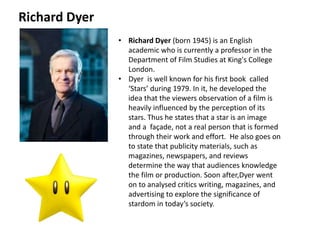
Dyer
- 1. • Richard Dyer (born 1945) is an English academic who is currently a professor in the Department of Film Studies at King's College London. • Dyer is well known for his first book called ‘Stars’ during 1979. In it, he developed the idea that the viewers observation of a film is heavily influenced by the perception of its stars. Thus he states that a star is an image and a façade, not a real person that is formed through their work and effort. He also goes on to state that publicity materials, such as magazines, newspapers, and reviews determine the way that audiences knowledge the film or production. Soon after,Dyer went on to analysed critics writing, magazines, and advertising to explore the significance of stardom in today’s society. Richard Dyer
- 2. Star Theory Richard Dyer’s Star Theory is therefore the idea that icons and celebrities are constructed by organizations for financial profit and gain and target one specific audience. His theory is spilt into three sections; 1) Audiences and Organisations – he believes that all these ‘stars’ today are created for money purposes . This is because it increases the brands identity, which benefits them as the organisation becomes the tending and popular name, which then results to increased sales in all of the different aspects of media, such as magazines, newspapers etc. The organisation then models the artist around the target audience they choose to maintain the high attention that they are receiving. This applies to the music industry, such as Nicki Minaj, as her fashion has to been chosen so that the audience can relate to her as a person and also her music.
- 3. 2) Constitutions - This is similar to the ‘audience and organization’ part of his theory; as he is saying that the star is built solely for an audience, not for themselves. Rihanna was constructed by Def. Jam Roc Nation(her record label)with fashions and make-up that would differ from others in the industry already. So the star itself accepts what is being done, due to wanting to become someone successful and noticed by the audiences. (example below of her changes throughout the years)
- 4. 3) Hegemony (Culture)- this idea by Dyer is that the audience relates to the star because they have a feature they the share or admire with the star through their findings within media. In addition to this, many fans will then try to attempt to replicate the star in their behaviour, what they and what they do, in order to become and fell like them. As well as a positive impact such as giving people confidence and self-assurance, and follow the correct footsteps into becoming someone like them, it also could be a negative impact as some stars often are heavy drinkers and drug abusers, and lead to the audience doing the same. Negative impact: Positive impact:
- 5. Star Theory Applied To My Own Star I will be included Dyer’s Star Theory into my own star, by applying the three sections. My star will relate mostly towards the audiences, which means that the audience will be taken into consideration as well as the trends of todays society, so that my star fits into the culture. My star is someone who stands out within the music genre I've chosen ( Hip- Hop/R&B) and so they will be notice and acknowledged immediately, rather than gradually, therefore they will be targeted to a broader audience instead of a niche one. In addition, though my star people will be able to share to issues, problems and find ways to over come it as well as other benefits. This will effect the organization as an instantaneous recognition means that more people are staring to recognise my star, which results to benefits, such as becoming popular.